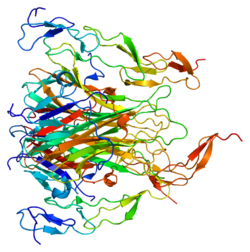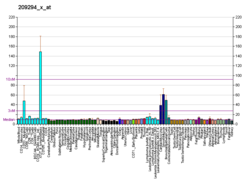Top Qs
Timeline
Chat
Perspective
Death receptor 5
Protein found in humans From Wikipedia, the free encyclopedia
Remove ads
Death receptor 5 (DR5), also known as TRAIL receptor 2 (TRAILR2) and tumor necrosis factor receptor superfamily member 10B (TNFRSF10B), is a cell surface receptor of the TNF-receptor superfamily that binds TRAIL and mediates apoptosis.
Remove ads
Function
The protein encoded by this gene is a member of the TNF-receptor superfamily, and contains an intracellular death domain. This receptor can be activated by tumor necrosis factor-related apoptosis inducing ligand (TNFSF10/TRAIL/APO-2L), and transduces apoptosis signal. Mice have a homologous gene, tnfrsf10b, that has been essential in the elucidation of the function of this gene in humans. Studies with FADD-deficient mice suggested that FADD, a death domain containing adaptor protein, is required for the apoptosis mediated by this protein.[5]
Remove ads
Interactions
DR5 has been shown to interact with:
Cancer therapy
Monoclonal antibodies targeting DR5 have been developed and are currently under clinical trials for patients suffer from a variety of cancer types, see Tigatuzumab (CS-1008).
Luminescent iridium complex-peptide hybrids, serving as TRAIL mimics, have been designed, which target the death receptors DR4 and DR5 on cancer cells and induce their apoptosis.[12]
See also
References
Further reading
External links
Wikiwand - on
Seamless Wikipedia browsing. On steroids.
Remove ads








